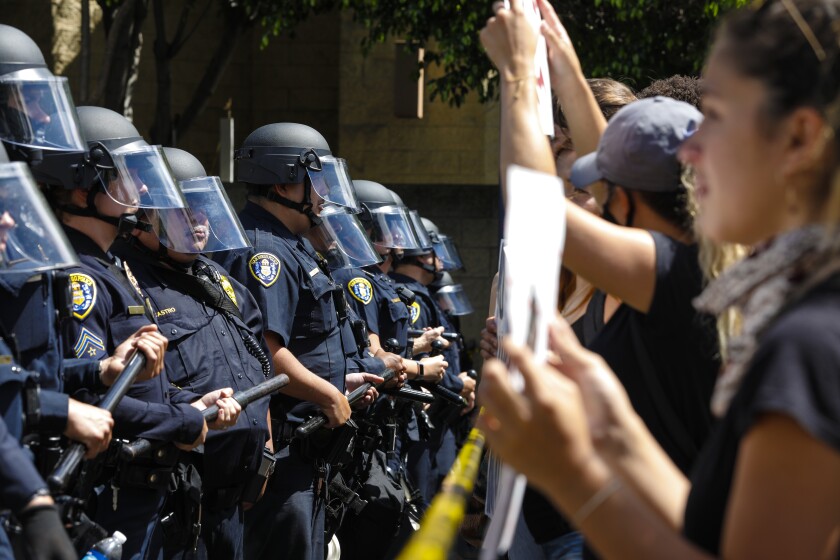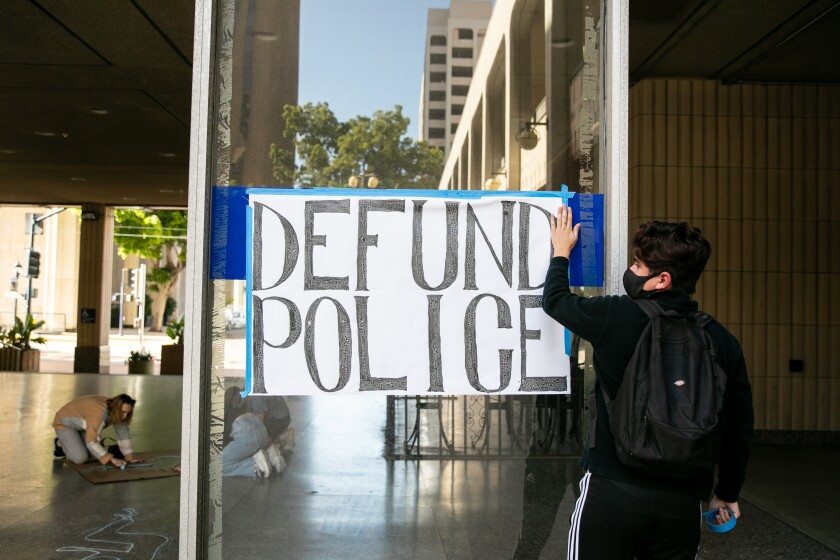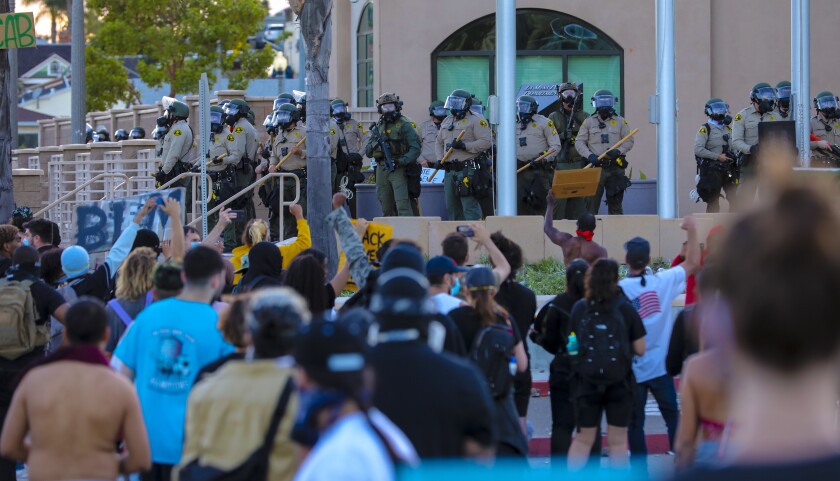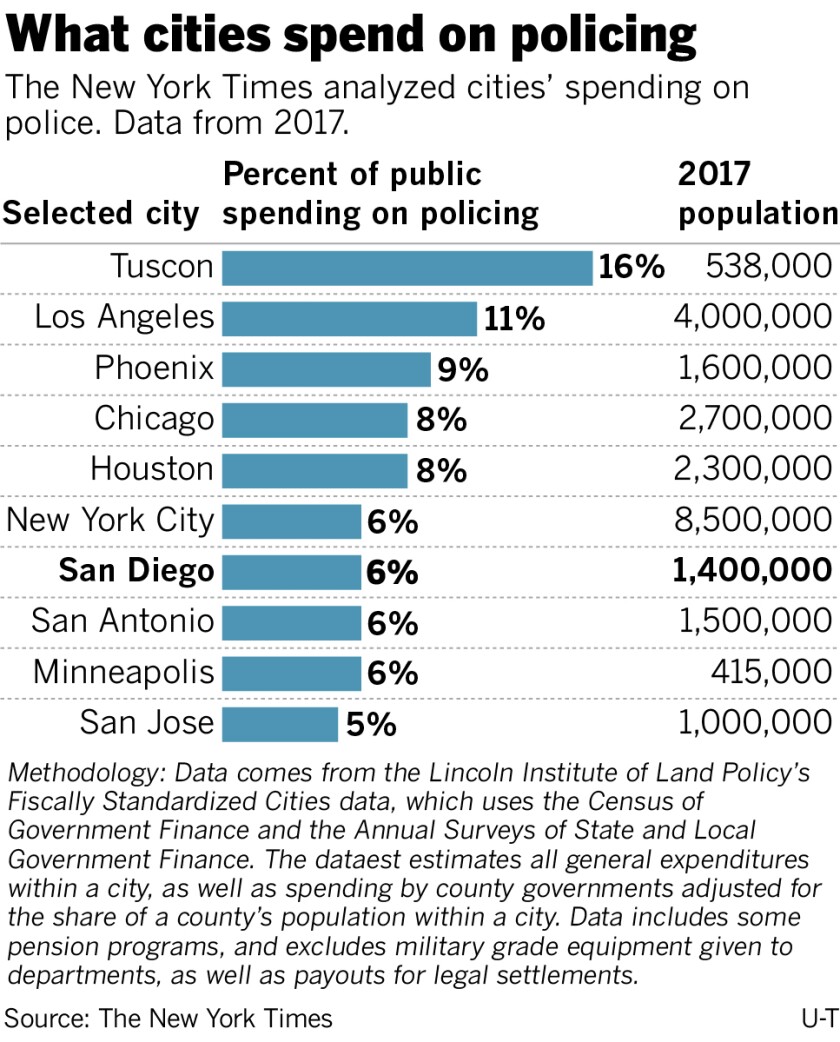Thousands of people pleaded with the San Diego City Council last week to roll back police spending in the new budget, one of many responses to the death of George Floyd at the hands of four Minneapolis officers.
But elected officials resisted the testimony from more than 400 callers and 4,000 others who emailed City Hall with their concerns.
Instead, the council boosted the police department budget by $27 million, outraging many, including members of the Black Lives Matter movement that has taken root in San Diego and across the nation.
The decision was staunchly defended by members of the council, who said the money is needed to pay for multi-year raises already awarded to police officers and to absorb some COVID-19 costs in the department.
Advertisement
The added law enforcement spending comes at a time when crime rates continue to decline and the number of police use-of-force complaints is rising.
It also furthers a years-long practice of directing more resources to the San Diego Police Department at the expense of other public services, according to a data analysis by The San Diego Union-Tribune.

Beginning July 1, San Diego Police Chief David Nisleit will oversee a budget of more than $566 million — 44 percent more than what the department spent a decade ago.
Advertisement
The city‘s overall general fund increased almost 37 percent over the same period.
Ten years ago, the police budget accounted for 34.9 percent of the general fund, the analysis showed. The latest plan sets aside close to 37 percent of general fund spending for police.
The budget priorities put forward by Mayor Kevin Faulconer and embraced by eight of nine council members were met with skepticism and dismay by people fighting for social justice and equality across San Diego’s communities.
“At a time we are seeing civil unrest across the country and new people come to the table to protest police brutality and the militarization of police, any elected body that chooses this time right now to say we need $27 million more is tone deaf at the very least,” said Christopher Rice-Wilson, associate director at Alliance San Diego, a nonprofit.
Advertisement

San Diego police officers hold the line at 14th Avenue and Broadway preventing protestors from getting any closer to the SDPD headquarters in downtown San Diego.
(Nelvin C. Cepeda / The San Diego Union-Tribune)
“Police budgets keep going up,” said Rice-Wilson, who waited eight hours to testify by phone last week but never got through. “It’s a reflection of folks in power thinking that more money in policing equals more safety.”
The trend toward higher police spending is more pronounced at the county level.
The San Diego Sheriff’s Department, one of the largest municipal law enforcement agencies in the western United States, has seen its budget climb to nearly $1 billion in annual spending.
Advertisement
Ten years ago, Sheriff Bill Gore oversaw a $611 million budget and 3,800 employees. This year, his expenses were set at $957 million, a nearly 57 percent increase.
Over the same decade, the county‘s overall budget rose by almost 29 percent.
In the city’s case, most of the new spending appears to be paying for higher salaries.
The San Diego Police Department budgeted 2,515 positions a decade ago. The fiscal-year budget that begins July includes money for 2,634 employees, a nearly 5 percent increase in staffing.
Advertisement
The Sheriff’s Department also increased its workforce by 16 percent over the past decade, to just over 4,400. Of those, about 2,550 are sworn deputies who patrol streets, investigate crime, staff county jails and protect courtrooms.
Gore’s department was responsible for almost 13 percent of the $4.9 billion county budget 10 years ago. His department now gets more than 15 percent of the annual spending plan, which has increased to more than $6.2 billion.
Orange County, with 3.2 million residents, is the closest in population to San Diego County’s 3.3 million people, according to 2019 U.S. Census data. The Orange County sheriff and coroner’s office, which are itemized together in budget records, have 3,600 employees and a $747 million budget — 11 percent of the county’s total spending.

Protesters gathered outside San Diego City Hall to draw 140 chalk outline, representing the 140,000 low-income residents they say are at risk of eviction if their budget demands aren’t listened to on June 8, 2020 in San Diego, California. The action came just hours before the City Council was considering Mayor Kevin Faulconer’s proposed budget. The advocates asked that some San Diego Police Department funding be diverted to a rental assistance program.
(Sam Hodgson / The San Diego Union-Tribune)
Advertisement
San Diego County has yet to adopt an overall budget for the fiscal year that starts July 1. Two months ago, as the COVID-19 pandemic widened and revenue dropped sharply, the Board of Supervisors put off consideration of a new spending plan until August.
But a budget proposed by Chief Administrative Officer Helen Robbins-Meyer recommends a $21 million drop in sheriff’s funding next year, primarily due to the removal of one-time spending items this year.
The Sheriff’s Department did not respond to questions about its budget.
San Diego police spokesman Lt. Shawn Takeuchi said the city’s added costs reflect the end of a years-long salary freeze, and the pay raises are to promote recruitment and retention.
Advertisement
Less for parks, libraries
In addition to promoting public safety through police and fire agencies, local governments are called upon to provide health services, clean water and sanitation, public transportation, streets and parks, libraries and a litany of other services.
But the runaway leader in local government spending historically is public safety.
In San Diego County, which spends $500 million a month on a smorgasbord of taxpayer services, only the Health and Human Services Agency surpasses public safety in spending.
Advertisement
Health and Human Services collected $2.2 billion in the current county budget, about $200 million more than the Public Safety Group, which includes the Sheriff’s Department, the District Attorney’s Office, child-support services, probation and other departments.
A decade ago, however, the Health and Human Services budget was $1.9 billion, or close to 40 percent of all county spending. The agency now accounts for 36 percent of the county budget.
While the sheriff’s budget has climbed, the department is reporting fewer arrests — and more use-of-force incidents.
In 2017 the Sheriff’s Department reported just over 24,000 arrests. The number plunged to 18,600 in 2018 and just over 17,400 last year, records show.
Advertisement
Over the same three years, the number of use-of-force incidents by deputies in the field rose over 10 percent, from 2,397 to 2,649, department records show.
The city of San Diego also has seen other public services give way to law enforcement.
Ten years ago, the city spent $112 million on parks and recreation — 10 percent of the general fund. The department had the equivalent of 840 full-time employees on the books.
The new Parks and Recreation Department budget lays out $117 million in spending while slicing 85 positions for a staff of 839 full-time positions. The 2021 workforce is one fewer than the city employed a decade ago, but spending for the department has dipped below 8 percent of the general fund, records show.
Advertisement
The city library system has similarly contracted under the new budget. Libraries stand to lose 20 percent of their workforce, going from 444 employees to 348 people.
The library spent $37.7 million a decade ago, or 3.3 percent of the general fund; the FY21 budget spends $52.8 million on libraries, or 3.4 percent of the general fund.
Crime drops
While San Diego‘s police budget keeps climbing, crime rates dropped exponentially. The declines affected nearly every category of crime, from murder to burglary, department records show.
In 2008, for example, police reported 58 murders; a decade later the number was 35.
Advertisement
Robberies dropped from more than 2,000 to just over 1,400, and car thefts plunged from over 10,000 to fewer than 5,200.
Last year the number of complaints against San Diego police that came before an oversight board grew.
The Community Review Board on Police Practices reviewed 59 cases last year at the request of Internal Affairs, compared to 43 in 2018. Its busiest year was 2014, when it reviewed 106 cases.

Sheriff deputies take up positions at an entrance to the La Mesa Police Department where more than a thousand protestors held a demonstration on Saturday.
(Nelvin C. Cepeda/Nelvin C. Cepeda/The San Diego Union-Tribune)
Advertisement
University of San Diego law professor Kevin Cole, who specializes in criminal law and procedure, said bureaucracies have a tendency to try to grow, and voters traditionally have been receptive to tough-on-crime measures.
“Even in an era of declining crime rates, some new and costly initiatives might make sense focusing on new challenges and priorities,” he said. “And crime victims aren’t comforted by knowing that they were victimized in an era of lower crime rates.”
That said, Cole added, “reductions might be cost-justified.”
Elected officials in San Jose, the Northern California city whose population most closely mirrors San Diego’s, did just that. Their 2020-21 budget trimmed the police budget by more than $15 million and cut seven positions from the department, budget records show.
Advertisement
‘That money does exist’
A cell-phone video showing a Minneapolis police officer pinning Floyd to the ground with a knee on his neck for more than eight minutes touched off demonstrations across the nation and world.
Both San Diego and La Mesa saw massive protests and some rioting and looting over the first weekend following the death.
Now protesters, who continue to take to the streets weeks after the killing, are demanding that public officials do away with what they consider as systemic racism in the criminal justice system and a general lack of accountability for officers guilty of misconduct.
Advertisement
A key rallying cry has been to defund the police and instead direct more public resources to housing, health and other services— the same message demanded by a majority of speakers at last week’s San Diego City Council meeting.
“I think we have police officers responding to calls about homelessness and other social work and mental health crises that they are not trained and prepared to respond to,” said Maresa Talbert, a lawyer and co-chair of San Diegans for Justice, a local coalition working to increase police accountability.
“Allocating funds to eliminate (police) from those types of activities, and work to focus in on crimes and criminals and police work would go a long way,” she said.

Advertisement
San Diego city and county are not alone in steering more tax dollars toward public-safety in recent years.
The New York Times reported Friday that across 150 large cities, the average share of general spending on police has increased by more than 1 percentage point since the 1970s, to almost 8 percent today.
The single-point increase is not insignificant; it represents hundreds of millions of dollars in annual public spending.
By comparison, the same cities invested an average of 5 percent of revenue on housing and 3 percent on parks.
Advertisement
Khalid Alexander, president and founder of the San Diego grassroots organization Pillars of the Community, said the steady rise in police and sheriff’s spending reflects the priorities of elected leaders.
“It’s no surprise that any time we are advocating for parks and education, the response is always ‘There is not enough money’,” he said. “But that money does exist. It has been going to law enforcement.”
Will of the people
By last Monday, when the San Diego City Council convened to consider Faulconer’s proposed city budget — and his request to boost police spending by $27 million — tensions were running high.
Advertisement
The meeting, which was held remotely due to COVID-19, stretched for more than 12 hours. Speaker after speaker implored their elected representatives to reject the mayor’s plan and divert some of that money to socially conscious programs.
“De-fund this city-sanctioned militia that is terrorizing black people,” resident Breana Clark said. “We need resources in our communities, not these thugs wearing a badge.”
In the end, however, the council voted 8-1 to approve the budget, including the added police spending. Councilman Chris Ward said he voted against the plan because it didn’t offer more help to small businesses hobbled by the coronavirus.
Mesa College political science professor Carl Luna said the lopsided vote against the vast majority of people who called in to the public meeting does not mean council members were ignoring their constituents.
Advertisement
“You cannot connect those comments to the will of the people,” he said. “That’s what we have elections for.”
Luna said City Council sessions are not the best way to measure the pulse of the people.
“Protesters tend to represent the most passionate people,” he said. “That being said, the council members have staked out a position they will be held accountable for on Election Day.”
Alexander, the Pillars of the Community founder, said the years of public spending that favored law enforcement over programs like housing, healthcare and education reflect poorly on American values.
Advertisement
“It’s an indictment of the politicians and us as a society — everybody who is not willing to say it is better to invest in social work than the police,” he said.
Some elected officials tried to explain their vote.
Council President Georgette Gómez, who is running for Congress this November, told the Voice of San Diego that she would have cut police funding but there were not enough votes from other council members to pass the spending reductions.
Several other council members said that, instead of reducing police funding this year, they preferred supporting better police training, stricter oversight, new procedures to de-escalate situations, and more proactive, neighborhood-oriented policing.
"eat" - Google News
June 14, 2020 at 08:04PM
https://ift.tt/3freDaT
San Diego's rising police, sheriff's budgets eat into other public services - The San Diego Union-Tribune
"eat" - Google News
https://ift.tt/33WjFpI
https://ift.tt/2VWmZ3q
Bagikan Berita Ini














0 Response to "San Diego's rising police, sheriff's budgets eat into other public services - The San Diego Union-Tribune"
Post a Comment